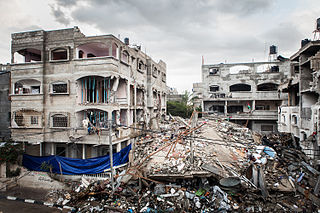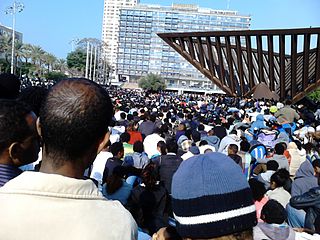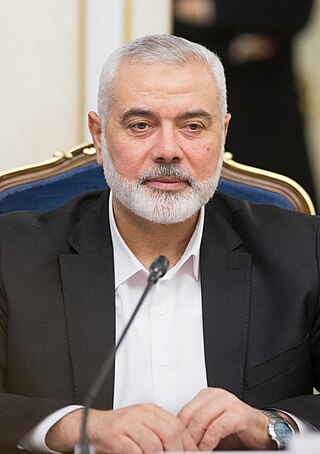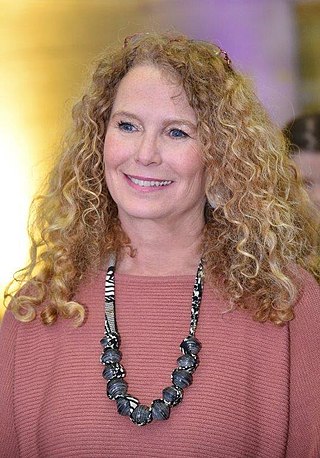Related Research Articles

The 2004 Sinai bombings were three bomb attacks targeting tourist hotels in the Sinai Peninsula, Egypt, on 7 October 2004. The attacks left 34 people dead and 171 injured.
There are tens of thousands of Sudanese refugees in Egypt, most of them seeking refuge from ongoing military conflicts in their home country of Sudan. Their official status as refugees is highly disputed, and they have been subject to racial discrimination and police violence.

Jabalia Camp is a Palestinian refugee camp created by the United Nations following Israel's war of independence in 1948. Despite its name, it is nowadays an urban agglomeration located 3 kilometers (1.9 mi) north of Jabalia in the Gaza Strip. It is the largest refugee camp in Palestinian territory, with more than 100,000 inhabitants.

Sudanese refugees in Israel refers to citizens of Sudan who have sought refuge in Israel due to military conflict at home, and to those who moved there illegally as migrant workers. In 2008, there were 4,000 Sudanese in Israel, 1,200 from Darfur and the remainder Christians from South Sudan. The majority entered through the Israeli-Egypt border. Most live in Tel Aviv, Arad, Eilat and Bnei Brak.

African immigration to Israel is the international movement to Israel from Africa of people that are not natives or do not possess Israeli citizenship in order to settle or reside there. This phenomenon began in the second half of the 2000s, when a large number of people from Africa entered Israel, mainly through the then-lightly fenced border between Israel and Egypt in the Sinai Peninsula. According to the data of the Israeli Interior Ministry, 26,635 people arrived illegally in this way by July 2010, and over 55,000 by January 2012. In an attempt to curb the influx, Israel constructed the Egypt–Israel barrier. Since its completion in December 2013, the barrier has almost completely stopped the immigration of Africans into Israel across the Sinai border.

Egypt–Palestine relations are the bilateral relations between the Arab Republic of Egypt and the State of Palestine. Egyptian President Gamal Abdel Nasser was a strong supporter of the Palestinian cause and he favored self-determination for the Palestinians. Although the Egyptian government has maintained a good relationship with Israel since the Camp David Accords, most Egyptians strongly resent Israel, and disapprove of the close relationship between the Israeli and Egyptian governments.
Sudanese refugees are persons originating from the country of Sudan, but seeking refuge outside the borders of their native country. In recent history, Sudan has been the stage for prolonged conflicts and civil wars, as well as environmental changes, namely desertification. These forces have resulted not only in violence and famine but also the forced migration of large numbers of the Sudanese population, both inside and outside the country's borders. Given the expansive geographic territory of Sudan, and the regional and ethnic tensions and conflicts, much of the forced migration in Sudan has been internal. Yet, these populations are not immune to similar issues that typically accompany refugeedom, including economic hardship and providing themselves and their families with sustenance and basic needs. With the creation of a South Sudanese state, questions surrounding southern Sudanese IDPs may become questions of South Sudanese refugees.
Nakba Day in 2011 was the annual day of commemoration for the Palestinian people marking the Nakba—the displacement that accompanied the creation of Israel in 1948. Generally held on May 15, commemorative events in 2011 began on May 10, in the form of march by Palestinian Arab citizens of Israel on Israel's Independence Day. On May 13, clashes between stone-throwing youths and Israeli security forces in East Jerusalem resulted in one Palestinian fatality, and clashes continued there and in parts of the West Bank in the days following.

The 2011 Israeli border demonstrations started on 15 May 2011, to commemorate what the Palestinians observe as Nakba Day. Various groups of people attempted to approach or breach Israel's borders from the Palestinian-controlled territory, Lebanon, Syria, Egypt and Jordan. At least a dozen people were killed when protesters attempted to cross the border from Syria.
Ahmed Mohamed Mahmoud was an Egyptian print reporter for the newspaper Al Tawuun, which is distributed by state-run Al-Ahram. He was shot by a sniper on the balcony of his office while filming the outbreak between Egyptian protestors and security forces on January 28, 2011 during the 2011 Egyptian Revolution. He died six days later in a local Cairo hospital, and he was the first journalist to die in Egypt during its Arab Spring uprising.
The 1948 bombings in Cairo, which targeted Jewish areas, took place during the 1948 Arab–Israeli War, between June and September, and killed 70 Jews and wounded nearly 200. Riots claimed many more lives.

Protests against the 2013 Egyptian coup d'état erupted in July 2013. Immediately following the removal of President Mohamed Morsi by the Egyptian Armed Forces on 3 July 2013 amid demonstrations against Morsi's rule, many protesters amassed near the Rabia Al-Adawiya Mosque to call for Morsi's return to power and condemn the military, while others demonstrated in support of the military and interim government. Deadly clashes such as Rabaa massacre continued for several days, with three particularly bloody incidents being described by officials as "massacres" perpetrated by security forces. During the month of Ramadan, prime minister Hazem al-Beblawy threatened to disperse the ongoing Pro-Morsi sit-ins in Rabaa al-Adaweya square and al-Nahda square. The government crackdown of these protests occurred in a violent dispersal on 14 August 2013. In mid-August, the violence directed by the army towards the protesters escalated, with hundreds killed, and the government declaring a month-long nighttime curfew.
Large numbers of refugee kidnappings in Sinai occurred between 2009 and 2014. Refugees from Sudan, Ethiopia and Eritrea were transported to Sinai and held hostage by members of Bedouin tribes. Typically, the hostages were forced to give up phone numbers of relatives and were tortured with the relatives on the phone, in order to obtain ransoms in the range of $20,000–$40,000. If the families could not pay, the hostages were killed. The Egypt–Israel barrier, designed to keep out African migrants, caused the Rashaida traffickers to lose income from transporting refugees to the border, so they started to concentrate on kidnappings.
The Saharonim Prison is an Israeli detention facility for African asylum seekers located in the Negev desert. It is the largest of a planned four camps with its total capacity of 8,000 inmates. Together with the Ktzi'ot prison, Sadot prison and the Nachal Raviv tent camp they detain South Sudanese, Sudanese and Eritrean asylum seekers who crossed the border from Egypt to Israel.

Ismail Haniyeh is a Palestinian politician who is seen as the overall political leader of Hamas, the de facto ruling entity of the Gaza Strip. He is the current chairman of Hamas’s political bureau; as of 2023, Haniyeh lives in Qatar.

Galia Sabar is the president of Ruppin Academic Center, one of Israel leading public colleges. Prior, she was a professor of African Studies at Tel Aviv University and the Chair of African Studies at the Department of Middle Eastern and African History at Tel Aviv University, where she also served as the coordinator of African Studies at the S. Daniel Abraham Center for International and Regional Studies. Sabar has published seven books and dozens of articles in professional journals. In addition to her academic research, Sabar has been a leading social activist in Israel mainly in relation to Ethiopian immigrants as well as in partnership with various NGOs assisting African labor migrants and asylum seekers. In May 2009, in recognition of her work combining academic rigor with social activism, Sabar received the Unsung Heroes of Compassion Award, sponsored by the international organization Wisdom in Action and delivered by the 14th Dalai Lama.
The 2019–2022 Sudanese protests were street protests in Sudan which began in mid-September 2019, during Sudan's transition to democracy, about issues which included the nomination of a new Chief Justice and Attorney General, the killing of civilians by the Rapid Support Forces (RSF), the toxic effects of cyanide and mercury from gold mining in Northern state and South Kordofan, opposition to a state governor in el-Gadarif and to show trials of Sudanese Professionals Association (SPA) coordinators, and advocating the dismissal of previous-government officials in Red Sea, White Nile, and South Darfur. The protests follow the Sudanese Revolution's street protests and civil disobedience of the early September 2019 transfer of executive power to the country's Sovereignty Council, civilian prime minister Abdalla Hamdok, and his cabinet of ministers. Hamdok described the 39-month transition period as defined by the aims of the revolution.
Usumain Tukuny Baraka is a Sudanese activist and asylum seeker living in Israel. He is a leader of Israel's asylum-seeking community and the first Darfuri refugee to graduate from a Hebrew-language program in an Israeli university.
Fergana massacre happened in 1989, after riots broke out between the Meskhetian Turks exiled in Uzbekistan and the native Uzbeks. Hundreds of Meskhetian Turks were killed or injured, nearly 1,000 properties were destroyed and thousands of Meskhetian Turks fled into exile.
References
- ↑ Global Statistics Archived 2008-10-11 at the Wayback Machine . Internal Displacement Monitoring Centre. Retrieved on 13 May 2013.
- ↑ Whitaker, Brian.”20 killed as Egyptian police evict Sudanese protesters.” The Guardian (December, 2005). Web. 24 Apr. 2016.
- ↑ Sabar, Galia and Tsurkov, Elizabeth. “Israel’s Policies toward Asylum-Seekers: 2002-2014.” Istituto Affari Internazionali, IAI working paper 15 (2015).Print.
- ↑ Archived at Ghostarchive and the Wayback Machine : The Massacre of Sudanese Refugees in Cairo. YouTube .
- ↑ Sabar, Galia and Tsurkov, Elizabeth. “Israel’s Policies toward Asylum-Seekers: 2002-2014.” Istituto Affari Internazionali, IAI working paper 15 (2015).Print.